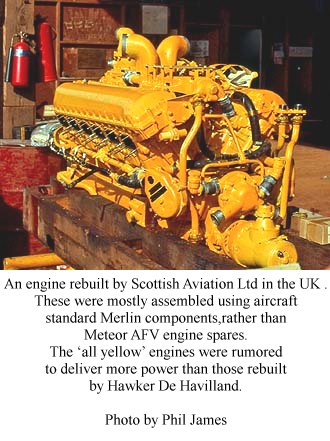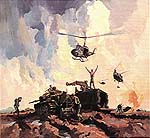
A Tale of Two Meteors: The Repetitive Lifecycle of a Tank Engine
The Rover Meteor Mk.4B and Mk.4B-H

But first, some general background to the Meteor tank engine. The original Meteor engine, the Mk.1, was developed by Rolls Royce at their Belper Works at Derby during the early part of the Second World War. Based on the highly successful Rolls Royce Merlin aircraft engine, the Meteor armoured fighting vehicle (AFV) engine was designed to use as many Merlin components as possible, either as new Meteor parts, or from the salvage of damaged Merlin aircraft engines. As the production standards for tank engines were not as rigid as for aircraft engines, parts rejected as unsuitable for use in Merlin aircraft engines were often within tolerances for use in the Meteor AFV engine, and were channeled into the Meteor production program as well.
The Meteor was very much the child of Merlin. The Mk.1 used a Merlin crankcase but with the reduction gear housing removed and a steel adaptor plate fitted to take a drive shaft and oil seal.
The first engine that entered series production, and would be used in several British tanks, was the Meteor Mk.1A and the later Mk.1C engines. These were manufactured, in whole or in part, by Rolls Royce, Nuffields, and Meadows, and more than 3,000 were produced during the course of the Second World War.
In October 1943, the Rover Car Company was given a contract to manufacture the newer Meteor Mk.3 engines (there was no Meteor Mk.2) which were used in later production Cromwell tanks, and exclusively in the Comet tank. Around 2,000 Meteor Mk.3 engines were built, all by Rover.
The development of the Centurion tank late in the war saw the Rover Car Company granted a contract to develop the Meteor Mk.4 engine. By this time, a deal had been struck between Rolls Royce and Rover that resulted in the transfer of all the development and production of the later model Meteor engines to Rover. The Mk.4 – basically a modified Mk.3 – developed around 550 bhp at 2,400 rpm.
An improved version, the Meteor Mk.4A, with an increased compression ratio produced 610 bhp at 2,400 rpm. Good, but further improvements would make it even better. The Meteor Mk.4B, which included many of the improvement modifications incorporated in the Merlin aircraft engines and a host of production improvements exclusive to the Meteor tank engine, developed a very respectable 650 bhp at 2,550 rpm.
Although drawing on the relevant Rolls Royce modifications to the Merlin, the Meteor Mk.4 onwards were exclusively a Rover Car Company development and manufacturing project, except for a small run of 150 Meteor Mk.4B engines manufactured by Jaguar in 1952 to prove tooling. The production line was then closed and placed in storage, ready to ramp-up production if it was ever required. On the other hand, the Rover Car Company manufactured over 7,600 Meteor Mk.4B (and Mk.4B-H) engines for the Centurion family of AFVs.
The Meteor Mk.4B was a conventionally aspirated, 60 degree ‘V’ configuration engine of two banks of 6 cylinders, most commonly described as a ‘V12’. The banks were identified as ‘A’ and ‘B’ banks, with ‘A’ bank on the left and ‘B’ bank on the right when looking toward the front of the tank. Each bank had cylinders numbered 1 to 6, with number 1 cylinder being the one nearest the fan drive end of the engine. Hence, the firing order is always described in terms of both the bank and the cylinder within that bank, thus: 1A-2B-5A-4B-3A-1B-6A-5B-2A-3B-4A-6B. A little cumbersome when compared to the more conventional system of simply numbering all the cylinders, but it is an English engine, after all, and nothing is ever simple!
The Meteor Mark 4B-H was essentially a Meteor Mk.4B with a modified wheelcase and mountings and drive for a hydraulic pump. Its use in the Australian Centurion fleet was exclusive to the four tanks equipped with the bulldozer modification, the hydraulic pump providing the pressure to operate the dozer blade.
Although there were further developments of the Meteor into various Marks and applications, the Australian fleet operated only the Meteor Mk.4B in tanks, Armoured Recovery Vehicles and Bridgelayers, and the Meteor Mk.4B-H in the dozer tanks. The two engine marks could not be ‘mixed’ in their application, and had different stock numbers.


